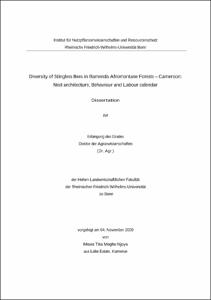Njoya, Moses Tita Mogho: Diversity of Stingless Bees in Bamenda Afromontane Forests – Cameroon : Nest architecture, Behaviour and Labour calendar. - Bonn, 2010. - Dissertation, Rheinische Friedrich-Wilhelms-Universität Bonn.
Online-Ausgabe in bonndoc: https://nbn-resolving.org/urn:nbn:de:hbz:5N-19936
Online-Ausgabe in bonndoc: https://nbn-resolving.org/urn:nbn:de:hbz:5N-19936
@phdthesis{handle:20.500.11811/4187,
urn: https://nbn-resolving.org/urn:nbn:de:hbz:5N-19936,
author = {{Moses Tita Mogho Njoya}},
title = {Diversity of Stingless Bees in Bamenda Afromontane Forests – Cameroon : Nest architecture, Behaviour and Labour calendar},
school = {Rheinische Friedrich-Wilhelms-Universität Bonn},
year = 2010,
month = jan,
note = {Until now almost nothing was known of invertebrates such as wild bees in the Bamenda highland forest region in Cameroon. This study focuses on honey producing bee species which do not possess functional stings. The diversity of the stingless bees in this area as well as their nest biology and behaviour was studied.
In all, Six species of stingless bees grouped into four genera exist in the Bamenda afro-montane forests. The four genera are: Meliponula (3 species), Dactylurina (1species), Hypotrigona (1 species) and Liotrigona (1species). The most represented of the species in Bamenda was Liotrigona.
Stingless bees were found to have huge variations in habitat preferences and in nest architectures. Nest designs differ with species as well as the habitats. Nest were found in tree trunks, mud walls, traditional hives, in soils or even just attached to tree branches. Brood cells and storage pots differ from species to species. Some species constructs combs while others construct cluster cells. Cell arrangement varied between horizontal and vertical doubled layered combs to clusters of cells.
Analysis of the behavior of stingless bees in an observation hive showed that the queen spends most part of her life on already provisioned cells. Workers clean the nest during the early hours of the day and dump the dirt just below the nest entrance. Workers were never seen laying trophic eggs. Bees are generally calm during manipulation. No case of attack on body parts was registered during the research period. The queen only become aggressive when disturbed from laying egg.
Results from study on division of labour among workers, showed that the lifespan of a workers of M. becarri range between 24- 73 days with an average longevity of 52.7days. Young workers 2 - 29 days were engaged nest construction. Workers starts foraging at the 25th day and last till they are 68 days old. The workers become guards after 55days. The most frequent tasks performed by surviving workers were: collection of resin (34.8%), construction of involucrum (33.3%), construction of pillar (31.1%) cerumen works (25.3%) and pollen collection (24.5%). Only 60% of surviving workers carried out foraging activities.},
url = {https://hdl.handle.net/20.500.11811/4187}
}
urn: https://nbn-resolving.org/urn:nbn:de:hbz:5N-19936,
author = {{Moses Tita Mogho Njoya}},
title = {Diversity of Stingless Bees in Bamenda Afromontane Forests – Cameroon : Nest architecture, Behaviour and Labour calendar},
school = {Rheinische Friedrich-Wilhelms-Universität Bonn},
year = 2010,
month = jan,
note = {Until now almost nothing was known of invertebrates such as wild bees in the Bamenda highland forest region in Cameroon. This study focuses on honey producing bee species which do not possess functional stings. The diversity of the stingless bees in this area as well as their nest biology and behaviour was studied.
In all, Six species of stingless bees grouped into four genera exist in the Bamenda afro-montane forests. The four genera are: Meliponula (3 species), Dactylurina (1species), Hypotrigona (1 species) and Liotrigona (1species). The most represented of the species in Bamenda was Liotrigona.
Stingless bees were found to have huge variations in habitat preferences and in nest architectures. Nest designs differ with species as well as the habitats. Nest were found in tree trunks, mud walls, traditional hives, in soils or even just attached to tree branches. Brood cells and storage pots differ from species to species. Some species constructs combs while others construct cluster cells. Cell arrangement varied between horizontal and vertical doubled layered combs to clusters of cells.
Analysis of the behavior of stingless bees in an observation hive showed that the queen spends most part of her life on already provisioned cells. Workers clean the nest during the early hours of the day and dump the dirt just below the nest entrance. Workers were never seen laying trophic eggs. Bees are generally calm during manipulation. No case of attack on body parts was registered during the research period. The queen only become aggressive when disturbed from laying egg.
Results from study on division of labour among workers, showed that the lifespan of a workers of M. becarri range between 24- 73 days with an average longevity of 52.7days. Young workers 2 - 29 days were engaged nest construction. Workers starts foraging at the 25th day and last till they are 68 days old. The workers become guards after 55days. The most frequent tasks performed by surviving workers were: collection of resin (34.8%), construction of involucrum (33.3%), construction of pillar (31.1%) cerumen works (25.3%) and pollen collection (24.5%). Only 60% of surviving workers carried out foraging activities.},
url = {https://hdl.handle.net/20.500.11811/4187}
}






